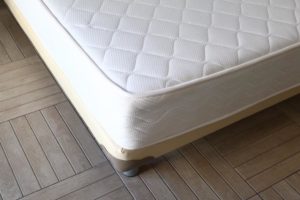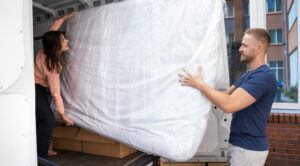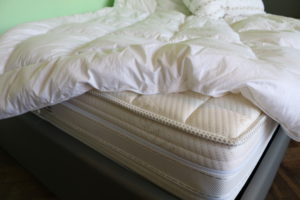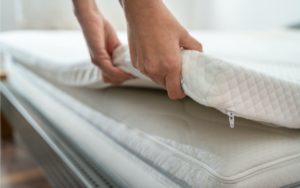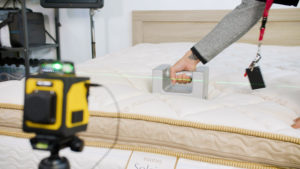How to Fix a Leaky Air Mattress
If your air mattress is sagging excessively or losing air at night, it’s possible that it has a leak. Depending on the type of leak, this can be relatively easy to fix. The guide below covers how to fix a leaky air mattress in a simple step-by-step breakdown.
How to Fix a Leaky Air Mattress: Step by Step
1. Confirm the leak
Before attempting to patch a leak, you’ll need to confirm that there actually is a leak happening. Air mattresses will naturally lose air over time, and this can be accelerated by temperature changes and other factors.
Before you begin trying to locate the source of the leak, fully inflate your air mattress. Then, lay on it for a few minutes, and see if it begins deflating. If it loses a noticeable amount of air, it likely has a hole or tear somewhere, meaning it’s time to move on to step two.
Let us help you find the perfect bed
Answer a few questions to find the right mattress for your unique needs
2. Locate the source
Air mattress leaks are usually caused by a small hole or tear in the vinyl. In some cases, the source of a leak could also be a damaged gasket. Either way, the next step is to locate the source.
Rips and tears will usually be quick to locate. For smaller holes, there are a few strategies to implement. First, fully inflate your mattress and place it upright against a wall, with the bottom facing you. Closely examine the surface, looking for any sign of damage. Check seams, as small cracks frequently appear in these areas. Gently press on the mattress, and listen for the sound of air escaping.
If you are unable to locate the leak this way, the next step is to head to the kitchen. Apply some dish soap to a clean kitchen sponge, rub it between your hands to get it very sudsy, and squeeze out most of the water. Rub the sponge all over the surface of the air mattress, and watch closely for growing bubbles. If an area produces larger bubbles, it’s likely that the leak is coming from this area.
3. Clean & mark the leaky area
Once you’ve located the source of the leak, clean the area thoroughly. Allow it to air-dry completely. Using a marker, gently circle the area of the leak so that you don’t lose track of it.
To get a patch to stick properly, you want as smooth of a surface as possible. If the air mattress has a rough or ribbed surface, you may need to gently sand it down using fine or very-fine sandpaper.
4. Patch the leak
Once the affected area is clean and fully dry, it’s time to patch the leak. Here are a few ways to do this, listed in order of effectiveness:
- Using the patch kit that came with your air mattress
- Using a third-party air mattress patch kit that you can purchase online
- Using a bike tire patch kit
- Using a homemade patch made from a thin plastic material, such as a shower curtain
If you plan to use a patch kit, simply follow the manufacturer’s instructions. If taking a DIY-approach, you may need to improvise a bit, depending on the size and severity of the leak as well as the material you are using for the patch.
Generally speaking, here’s how to go about applying a patch to a leaky air mattress:
- Completely deflate the air mattress and seal it closed.
- Ensure the leaky area is completely clean and dry.
- Adjust the mattress to ensure the leaky area is on a flat surface and fully exposed.
- Apply the patch to the affected area, ensuring there is at least half an inch of coverage around all sides of the leak.
- If using a bandage-style patch, the patch itself should be adhesive and it can be placed directly over the leaky area.
- If using a simpler patch, you will need to apply a strong glue or adhesive to the perimeter of the patch before application.
- Once the patch is applied, place a heavy, flat object on it to ensure the edges don’t curl up.
- Allow the patch to dry for at least 8 hours.
- Carefully inflate the mattress, testing for leaks.
Following these instructions, you should be able to successfully patch your air mattress. Once it’s repaired, remember to check the patch frequently to ensure it’s not peeling off. You may have to repeat the process if the patch seal weakens and begins leaking again.
Frequently Asked Questions
How do you find a leak in an air mattress?
The best way to locate a leak is to apply a soapy sponge to the surface of a fully-inflated mattress. Watch for any areas where bubbles form and grow, indicating a possible leak. Alternatively, you can fully inflate the mattress, and simply listen for the sound of escaping air. You can also submerge the mattress in water to look for escaping bubbles, although this is impractical with a large mattress.
How do you fix an air mattress without a patch?
If you don’t have a patch, you will need to make your own. The best materials to use are thin, flexible plastic materials, such as shower curtain liners. Cut a patch to match the size of the leaky area, ensuring that there is about a half-inch of material on all sides of the hole. Choose an adhesive and coat the perimeter of the patch with it. Fully deflate the air mattress, clean and dry the affected area, apply the patch, and allow it to fully dry to form a tight seal.
How do you fix a leaky gasket or seal?
If the air mattress leak is coming from the gasket itself, the fix may be more difficult. If you have an owner’s manual for the mattress, or you can find one online, check that first to see if a fix is described. In many cases, a leaky gasket will need to be completely replaced.
How do you fix a leaky seam?
If your leak is coming from a seam, the patching approach typically will not work. Instead, you can use a hot glue gun, or a high-strength glue, to seal the hole. If it’s a large tear, you may need to fold the surrounding material in on itself, gluing the sides together. Be very careful when using a hot glue gun, as the heat of the metal tip can melt the surface of the air mattress.

Still have questions? Ask our community!
Join our Sleep Care Community — a trusted hub of sleep health professionals, product specialists, and people just like you. Whether you need expert sleep advice for your insomnia or you’re searching for the perfect mattress, we’ve got you covered. Get personalized guidance from the experts who know sleep best.










